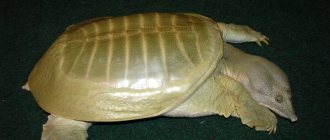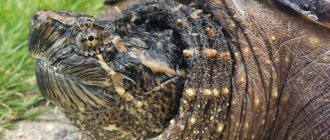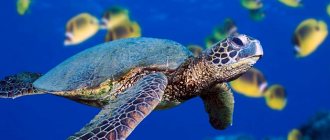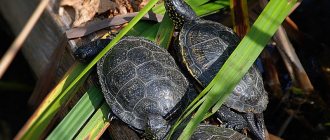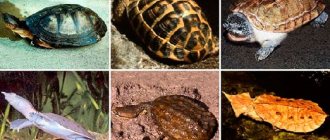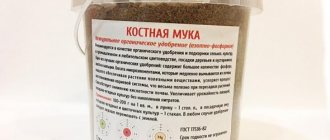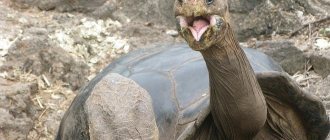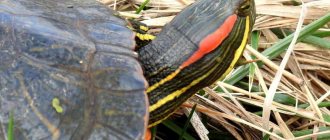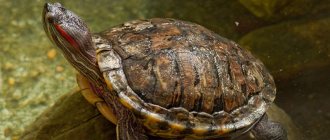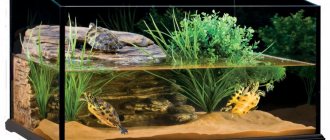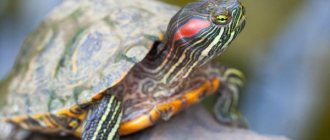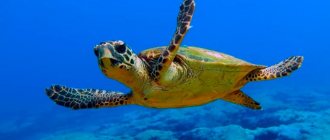Name (Rus): Central Asian SteppeRussian Horsfield's Tortoise Name (latin): Testudo horsfieldiiAgrionemys horsfieldiiAgronemys horsfeeldii Subspecies: (Testudo horsfieldii kazachstanica) (Kazakh steppe) (Testudo horsfieldii rustamovi)
Description of the Far Eastern turtle
Chinese Trionix has expressive external features characteristic of representatives of the superfamily of soft-bodied turtles. These include a soft leathery shell, an elongated snout with a trunk and powerful webbed feet. The Far Eastern turtle does not have bright colors, and throughout its life it remains of average size.
Appearance, dimensions
The Far Eastern turtle is a soft-bodied turtle. There are no horny scutes on its carapace; it is covered with skin on top. The length of the carapace is 20-25 cm, but in some specimens it can reach 40 cm. Weight is up to 4.5 kg.
The young Trionix has a round shell with tubercles on it. As they grow older, the growths merge together, and the carapace stretches along the edges and becomes oval and almost completely flat. Individuals have thin skin and a weak skeletal system. The shell contains a small bony plate consisting of several elements, surrounded by cartilage. The plastron also consists of cartilage.
The Far Eastern tortoise has a very long neck. The head is medium in size with an elongated trunk through which the animal breathes, and a powerful jaw with sharp horny edges.
Trionix's paws have 5 toes, connected by membranes. The 3 toes of each paw end in sharp claws.
The color of the shell is gray or gray-brown, with a greenish tint. The body is green-gray, and the plastron is yellow or pinkish. There are a small number of dark spots on the head, sometimes stripes are visible.
Lifestyle
The Far Eastern turtle lives in fresh water bodies. She chooses places with a muddy or sandy bottom that are well heated by the sun. The animal tries to avoid rivers with strong currents. Trionix spends most of its time underwater, but on sunny days it can stay on land for a long time to warm up.
When leaving the reservoir, the turtle does not move further than a couple of meters from the water. This is due to the fact that on land this species feels less protected than in water. The lack of a durable shell causes injury and does not provide protection from predators; drying out in the air also poses a health threat. Despite the ability to run very quickly on land, the animal prefers to stay out of water for a short time and takes off with lightning speed in case of danger.
In the aquatic environment, the Far Eastern turtle swims very quickly thanks to its developed large webbed paws; it behaves actively and moves a lot. The animal prefers a solitary lifestyle; living together next to other representatives of the fauna ends badly.
To hide from predators or to keep warm, Trionix often buries itself in sand or silt, leaving only its nose on the surface. In places where the Far Eastern turtle buried itself in the sand, holes called “beds” are formed. The long neck and elongated trunk allow you to breathe without floating to the surface. Individuals are capable of staying under water for a very long time and swimming to great depths. They receive part of the oxygen directly from the water using the so-called pharyngeal breathing.
When underwater, the turtle periodically opens its mouth so that the water washes the villi in the throat, also called papillae. A unique feature of this species is that the papillae also serve as the urinary system. The Chinese Trionix is the only turtle that eliminates liquid excrement through the mouth. This method frees the kidneys from filtering water.
Trionics is nocturnal. After dark, all its active life activities take place - hunting, feeding, reproduction.
The Far Eastern tortoise is an aggressive animal. The sharp edges of the jaw can cause serious damage when bitten. The long neck helps the turtle to reach its attacker from any side. It is not recommended for a person to pick up a wild specimen, as it will instantly react and bite. Even when kept at home, this animal often shows aggression towards its owner.
Wintering lasts 3-6 months, it takes place at the bottom of reservoirs or in reed thickets near the shore.
Lifespan
In its natural habitat, the Far Eastern tortoise lives on average 20 years. In captivity, under suitable conditions, life expectancy increases to 30 years.
Sexual dimorphism
Turtles become sexually mature at 5-7 years of age. During this period, differences between males and females appear. Males have larger and more developed paws, and the claws are much longer. If you compare two individuals of different sexes, it becomes noticeable how much thinner and more graceful the females are.
Males have a depression on their plastron that allows them to hold onto the female during mating. There are leathery growths on their thighs, and the shell completely hides the tail.
Female individuals have a smooth or slightly convex abdomen, and their long tail is clearly visible.
Buying a healthy pet
In order not to run to the veterinarian the next day to prescribe treatment, it is better to immediately buy a healthy turtle
Pay attention to everything:
- observe her behavior, activity and coordination of movement;
- the appearance must be free of damage and the presence of inappropriate stains;
- the carapace is of regular shape with even scutes densely adjacent to each other;
- the best way to determine whether a turtle is healthy is to look into its mouth: the mucous membrane should be free of plaque, light pink in color and without viscous saliva;
- There should be no discharge from the nose.
Don't forget about transportation. For short distances in the warm season, it can be carried in a cardboard box with paper inside. In autumn and winter, it is better to cover the passenger with a warm cloth and place a heating pad there.
Range, habitats
The Far Eastern tortoise is widespread in Asia. The animal lives in Japan, Korea, Eastern China, Vietnam, the islands of Taiwan and Hainan. This is the only species of soft-bodied turtles that is found in Russia, namely in the south of the Far East.
Trionics has been successfully introduced into southern Japan, Thailand, Malaysia, the Hawaiian and Mariana Islands. Turtles brought from outside were able to take root in their new environment.
Individuals live exclusively in fresh waters with calm currents. Reservoirs can be both large and small, with gently sloping banks and sparse vegetation. Sometimes found in flooded rice fields in China. Habitats in Russia include the Amur and Ussuri rivers and Lake Khanka.
In cases where the turtle’s place of residence becomes shallow or polluted, the individuals do not leave the house and remain in the same place. A special urinary system allows them to remain in contaminated water without harm to health, since fluid filtration by the kidneys does not occur.
Diet, nutrition of Chinese Trionix
Trionics is a predator. The turtle poses a great danger to the smaller inhabitants of the reservoir, although sometimes large individuals are included in the diet. During the daytime, Trionix hides in sand or silt and waits for its prey, sticking out only its trunk. When approaching, the predator reacts with lightning speed and grabs the prey with a quick movement of its head. Due to its long neck, it can grab prey without leaving its ambush.
At night, the turtle prefers active hunting. Thanks to its high speed, it can easily catch up with its prey, and its powerful jaw and paws allow it to quickly get rid of food.
The animal feeds on fish, amphibians, crustaceans and mollusks. Worms and some insects are eaten. Far Eastern turtles eat a lot; at home, they eat several fish 10 cm long at once. A tendency to eat food in large quantities is observed in all age categories of Chinese Trionix.
Care
Caring for a marsh turtle is not difficult, the main thing is to recreate natural conditions. Maintain the aquaterrarium in a timely manner, monitor the diet and temperature, monitor your pet, and if you suspect an illness, do not delay treatment, then the marsh turtle will live a long time.
Stern
Unlike land turtles, European marsh turtles are predators. Feed your pet a variety of foods:
- lean fish (haddock, pollock, cod, perch);
- small snails and crustaceans;
- earthworms;
- bloodworm;
- mussels;
- shrimp;
- baby frogs;
- live aquarium fish;
- branded food.
Protein foods are the basis of the diet. Serve moist food at room temperature. Vegetable feeding is also required (15% of the diet):
- dandelion leaves;
- salad;
- spinach;
- non-acidic fruits;
- carrot;
- duckweed.
While feeding, the reptile scatters pieces of food and quickly pollutes the water. To keep the water clean, feed the animal in a different container. Give food to young individuals and pregnant females every day, to adults - once every 2-3 days. Unlike land turtles, European marsh turtles are easy to train. Feed with tweezers, pets will stretch their heads to take food. Hand feeding is not advisable, as later the animal associates hands with eating, which makes independent feeding difficult. Nutrition occurs in water.
Hygiene
It is enough to wipe the shell of a swamp reptile with a soft sponge or brush without soap once a week. Use warm water. If the turtle is not in the mood, wait for the right moment.
Age determination
Find out the age of the reptile by the rings on the scutes of the shell. During the first two years of life, the growth ring appears within 3–6 months. After this, one ring is added annually. The pattern of an elderly marsh turtle is unclear. You can also find out the approximate age of a reptile by the length of its shell. In newborns, the length of the shell is up to 3 cm; every year the shell becomes 2 cm longer. By one year, the reptile has a 5-centimeter shell, while a two-year-old turtle has 7 cm.
Reproduction, offspring
After reaching sexual maturity at 5-7 years of age, Far Eastern turtles begin breeding from March to June, depending on the climatic conditions of their place of residence. Mating occurs shortly after emerging from hibernation.
During the process of fertilization, the male bites the female on the neck or paws, thereby holding her tightly. Copulation is carried out in water for 5-10 minutes.
The duration of pregnancy is 50-65 days. Dry places on the shore of a reservoir are chosen as the place where females lay eggs. The soil where the eggs will be stored must warm up well. Turtles try to place eggs near bodies of water at a distance of 4 to 35 meters from the water. The female digs a hole 15-20 cm deep and 10 cm in diameter, places eggs there and covers it with soil or sand. The hole is located in a high place to avoid being washed away by water during floods.
Egg laying occurs from May to August. In one season, a female can make up to three clutches with a break of several days. The total number of eggs varies on average from 18 to 75 pieces. Their number depends on the age and size of the individual - the larger the trionix, the more eggs it can lay.
Turtle eggs are spherical in shape, their diameter is 20 mm, and the color is white with a beige tint. The incubation period until the young hatch is 40-60 days. In hot weather and temperatures above 33°, turtles may hatch earlier; the incubation period is reduced to 30 days.
In August and September, turtles hatch and run to the water. The size of their shell at this time is 3 cm. It takes them approximately 40 minutes to cover a distance of 15-20 m. Once in the water, trionics burrows into the mud at the bottom or hides under stones.
Content
Arrangement of the terrarium
There must be soil consisting of large pebbles in a warm corner, sawdust/wood chips/hay. Feeder and house.
An incandescent lamp (40-60 W) is a source of heat, creating a necessary-sufficient temperature gradient at which the reptile itself can choose the ideal temperature for it
The vital importance of heat contributes to the development of processes in which the turtle is able to warm itself only thanks to external heat sources and thereby ensure the normal functioning of the body. In the absence of heat, decreased metabolism slows down even more
Food rots in the stomach without being digested, which can lead to gastrointestinal disorders. The temperature regime in the cold corner of the house is about 24–26 ° C and 30-33 ° C in the warm corner under the lamp. The temperature of the lamp can be adjusted by raising or lowering the lamp, or by installing incandescent lamps of different wattages.
A special ultraviolet lamp for reptiles (10% UVB) should be located at a distance of 25 cm from the animal (no higher than 40 and no lower than 20). The UV lamp does not heat the terrarium, but provides the turtle with the necessary ultraviolet light, which is needed for natural life activity - the absorption of vitamin D3, calcium and all necessary microelements. In nature, the turtle receives it through the sun's rays.
Turtles prefer to “seek shelter” themselves by burrowing into the gravel. Any draft or sudden change in temperature, even in a terrarium, can cause colds in animals.
corral for turtle
This is done in one of the free corners of the room. The heating lamp is located at one of the walls of the pen. The turtle itself is able to choose the temperature it needs at the moment. In the summer, it’s a good idea to set up a pen on your summer cottage. To make it easy to find the “hidden” turtle, you can attach a balloon or a noticeable flag on a high pole to the carapace with tape. If temperature conditions allow, you can leave the turtle in the pen overnight.
Free content
on the floor in the house is not allowed! The exception is if the pen is on a fenced and heated floor with soil, without drafts and temperature changes, with the necessary lamps.
Care:
It is advisable to bathe turtles in regular warm water once every 1-2 weeks. Water temperature 31–35°C. Height – up to the level of the turtle’s head (2/3 of the height of the shell). Such a bath replenishes the water-salt balance and moisture reserves in the reptile’s body, normalizes intestinal function. No water additives are required.
Natural enemies
The main enemies of the Far Eastern turtle are birds of prey and mammals. They pose a great danger to the population, as they destroy clutches by digging up turtle nests. In this way, sometimes 100% of the laid eggs disappear. Hatched turtles often do not reach the water, becoming prey to predators. Animals that cause harm to offspring include crows, foxes, raccoons, badgers and wild boars.
An attack on an adult is unlikely to be successful - it is not easy to catch up with the animal both in water and on land. In addition to speed, the turtle has a great bite force and can scare away the enemy.
Species status, population
The Far Eastern tortoise is listed in the IUCN (International Union for Conservation of Nature) Red Book as a “vulnerable species” and in the Russian Red Book since 1978. In Asia, Trionix is a widespread species that is often found in water bodies and successfully maintains its population. In Russia, the number of turtles is declining every year and the species is considered rare. The main distribution areas of the animal were the Amur and Khankai regions.
The population decline in Russia is caused primarily by poaching. Turtles began to be caught and sold to the Chinese market, where the meat of the animal is highly valued and consumed as food. Most often they are caught with a fishing rod or spear. Trionix eggs are used for the same food purposes.
Floods and washing out of clutches, as well as predatory animals that destroy their offspring, prevent turtles from restoring their numbers. Trionix often gets caught in fishing nets and cannot get out of them.
To preserve the species, catching turtles in Russia is strictly prohibited.
In Japan, the animal is considered sacred and is kept in special ponds near temples. Turtle meat is considered a healing dish.
The Far Eastern tortoise is a very interesting and unique animal in its own way. Despite the soft shell, the adult easily defends itself from enemies thanks to its high speed and strong jaw. The long neck and cartilage in the carapace allow one to reach the offender from any position. The Chinese trionix adapts to any water and is able to survive burrowing in the sand for a long time. At the same time, a dangerous predator often becomes a pet and lives safely in a heated aquaterrarium.
Reindeer
This animal has extraordinary hooves. During the warm period they resemble a soft sponge, but in winter they become coarse, and when a deer moves, their edge crashes into the ice like an icebreaker. Another distinctive feature of reindeer is their antlers. They are present in individuals of both sexes.
Caucasian otter. It reaches up to 70 cm in length and has a strong, muscular tail that helps it swim. The otter prefers to sleep during the day and stay awake at night.
Using the example of the above list, it becomes clear which animals in the Red Book are subject to protection at the legislative level. Photos of animals from the Red Book can be found by reading the printed version or online version of the document.
